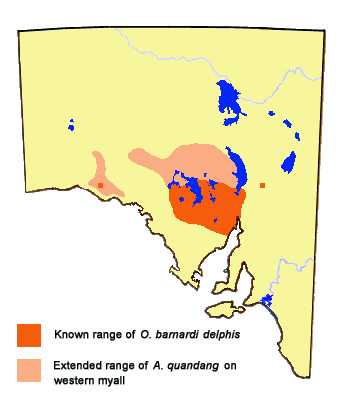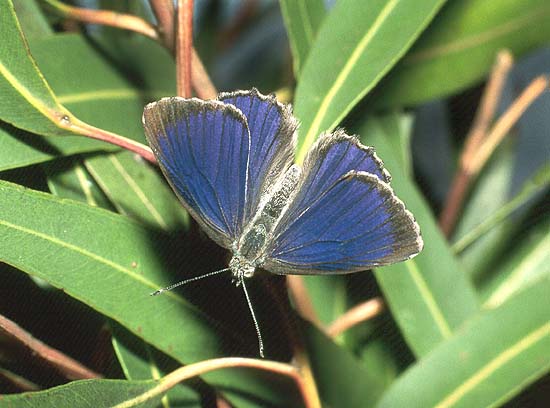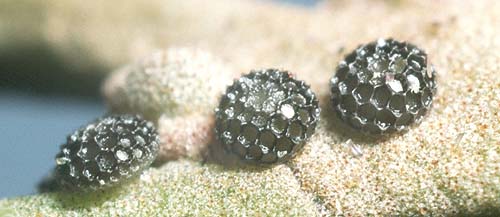-
Larval Food Host
-
Amyema quandang var. quandang (grey mistletoe) (Loranthaceae).
The larvae eat the flower buds, flowers, leaves and soft stem parts of the mistletoe.
The female is known to lay eggs only on A. quandang in South Australia,
although in captivity the larvae will eat other Amyema mistletoes.
-
Larval Attendant Ant
-
The larvae are attended by a few small dark brown and black ants
Crematogaster species.
-
Eggs
-
Small, dark grey to black, hemispherical shape, basally flattened,
the top is domed. The sides are coarsely reticulated in a hexagonal
pattern that continues to the small pale-coloured depressed micropylar
area on the top of the egg. At each reticulation intersection there is a
small raised blunt projection. Some eggs may be a washed out grey or white
colour. The egg is typical of the eggs for the O. olane Species
Subgroup. They are usually laid singly, on the leaves, stems and bole of the
hostplant, and sometimes on the adjacent host plant. The eggs start to hatch in
about 13 days in late spring. There is usually a very large population of tiny
parasitoid wasps on the mistletoe and very few eggs survive parasitisation.
-
Larvae
-
The first instar is pale greyish yellow, later becoming pale brown or green
after eating the young leaves of the hostplant. Long onisciform shape,
with scalloped lateral edges. The posterior dorso-lateral organs are not
developed. The head is large, smooth, brownish yellow, hidden beneath the
body. There are long dark peripheral and dorsal setae, which are longest
anteriorly, posteriorly and dorsally. Dorsal setae occur in two pairs, one
pair being long and recurved, the other pair being short, recumbent and
directed to the rear. Intermediate instars gradually lose the long dorsal
setae and gain the posterior dorso-lateral organs, and are onisciform
(slater shaped). They are pale brown or green coloured initially, later
becoming greenish brown or greyish green.
First and second instar larvae remain exposed on the leaves of the mistletoe
where their colour matches the leaves, but by the third instar as they grow
larger and more easily recognisable to predators they will begin to hide
during the day, and feed at night. The young larvae initially eat the young
tips of the mistletoe, but by about the late third instar they will also
eat the older leaves. Older larvae shelter during the day under coarse flaking
(but secure) bark near the hostplant, or in borer holes or ant tunnels in the
mistletoe or mistletoe host, or in other leaf debris caught up in the mistletoe
or near the hostplant. Larvae of O. barnardi will also cohabit with
the gregarious larvae of the day-flying black and white mistletoe moth (Agaristidae),
which usually take up residence in leaf debris within or near the mistletoe.
Only small numbers of larvae are normally present on (or near) each mistletoe
that is being utilised by the butterflies.
The fifth (final) instar is about 22 mm long, pale greyish green colour, anterior and
posterior extremities are dark brown,there are very pale brown dorsal chevron
markings and other subdorsal markings, the anal and prothoracic plates are dark
brown. Onisciform shaped with a thoracic dorsal furrow, the lateral edges are weakly
scalloped, and the anterior and posterior areas are flattened. The body is covered
in brown and black coloured, minute secondary setae, which are recumbent, club shaped
and rough in appearance, set on a protuberant,angular and ridged base. The secondary
setae impart a scabrous appearance to the larvae. The posterior dorso-lateral organs
are well developed. The head is small, smooth, yellowish brown, hidden beneath the body.
-
Pupae
-
Short cylindrical, rounded anteriorly and posteriorly, about 13-15 mm long,
grey coloured soon after pupation, but after a day they turn brown, with
a darker dorsal line, and other darker cryptic markings. There is a pair
of large, dark brown dorsal spots above the head. The surface of the pupa
is without hairs, but bears a reticulated pattern (similar to the eggs)
that produces a very fine scabrous surface, and which includes minute
specialised secondary setae that are more common around the spiracles.
In captivity, the butterflies emerge during the late afternoon.
The pupal period is about 13-15 days during mid-summer in captivity.
Pupation usually occurs well away from the mistletoe towards the base of
the Western Myall host tree where coarse flaking bark and other places
to hide are more prevalent. They will also pupate in the leaf debris
shelters of the mistletoe moth, although these shelters can also sometimes
contain huge spiders. Larvae will pupate gregariously near each other.
Pupating larvae surround themselves with a loosely webbed, silken cocoon-like
shelter, which presumably affords some protection from larger predators,
or from other O. barnardi larvae which can cannibalise soft pupating
larvae. There is normally space within the silk webbing for the small
attendant ants to pass through to attend to the live pupae. Pupae are
attached to the silked substrate by anal hooks and a central girdle.
The pupae are known to stridulate, making a series of audible clicks, which are
believed used as a means of communicating with the attendant ants. There is
usually at least one ant in attendance with a pupa.
-
Flight Period in South Australia
-
The butterfly is known to fly in spring and autumn, with the main flight
during spring, which coincides with the flowering of the mistletoe hostplant
that are used for nectaring purposes by the adults. However, in captivity,
eggs laid in spring will produce adults in summer. A summer flight in the
wild has yet to be witnessed in South Australia, although the nominotypical
subspecies that occurs in NSW and Qld flies all year round. In captivity,
a brood can be completed in about 12 weeks during late spring-early summer.
Larvae can go into a torpid (semi-hibernation) state over winter.

-
Distribution
-
In South Australia this butterfly has only been found near its hostplant
mistletoe (and its main mistletoe host tree the Western Myall,
Acacia papyrocarpa), and in some areas nearly every myall tree
can harbour mistletoe. This combination myall/mistletoe occurs mainly
in northern Eyre Peninsula, the Gawler Ranges, andsouthern pastoral
areas from the Nullarbor Plain and Tarcoola to Roxby Downs. The known
range of the butterfly is presently northern Eyre Peninsula, the Far
West Coast-east Nullarbor Plain Region, the Gawler Ranges and areas
between Port Augusta and Lake Torrens. There is also a record of the
butterfly at Wilpena in the Flinders Ranges. The frequency of the
butterfly deteriorates at the edges of the myall/mistletoe distribution.
The distribution of the butterfly in South Australia is probably more
extensive than known, based on the distribution of the myall/mistletoe,
especially in the southern pastoral areas. Interestingly, the butterfly
has yet to be seen in the north Nullarbor Plain and Tarcoola to Roxby
Downs Region. The mistletoe also occurs (less frequently) in northern
pastoral areas on other Acacia trees such as A. cambagei,
which grows along watercourses, and it is possible the butterfly may
eventually also be found in this habitat. Its mistletoe host also occurs
along the east side of the SA border south of Broken Hill, parasitising
Acacia loderi. However the butterfly has yet to be seen in that
area. The local subspecies delphis of the butterfly only occurs
in South Australia. The nominotypical subspecies of the butterfly occurs
in inland northern NSW and southern Qld, in the Brigalow
(Acacia harpophylla) woodlands.

-
Habitat
-
The butterfly has only been found in the Western Myall woodlands
that occur in a semi-arid habitat just north of the limits of
broad-acre agriculture. The Western Myall grows best in a
hot-temperate semi-arid habitat in a plains situation having
an annual rainfall of about 150-250 mm. In this situation,
the Western Myall can be the dominant tree in the woodland.
-
Conservation Status in South Australia
-
The butterfly is usually locally common when in flight, and quite often
every Western Myall tree that harbours hostplant mistletoe can have
at least one or two butterflies flying around it during the day.
-
Threats
-
Not generally under threat except where the habitat is adjacent to
farming communities and affected by poison spray drift during crop
spraying activities, especially when the poison is applied by aerial
means.The A. quandang mistletoe is mostly parasite specific
to the Western Myall tree, and the latter seems to have adjusted to
the affects of the mistletoe (partially symbiotic), and large trees
with their mistletoe can be a couple of hundred years old.In fact,
in periods of drought the myall can selectively kill off some of
the mistletoe growing on the tree allowing the latter to conserve
water. Rabbits affect regeneration of Western Myall, and in some
areas with a high rabbit density there has been very little
regeneration since European settlement.During historic periods of
drought the huge piles of leaf litter beneath the Western Myall
trees were used to sustain stock (instead of destocking), and this
can have an effect on the water mulching retention beneath the trees
in the hot summer months, particularly trees in the hot northern
areas of their range, which can cause the death of the tree.
-
Conservation Strategy
-
None required, except that any spraying activity should
be carried out judiciously.





